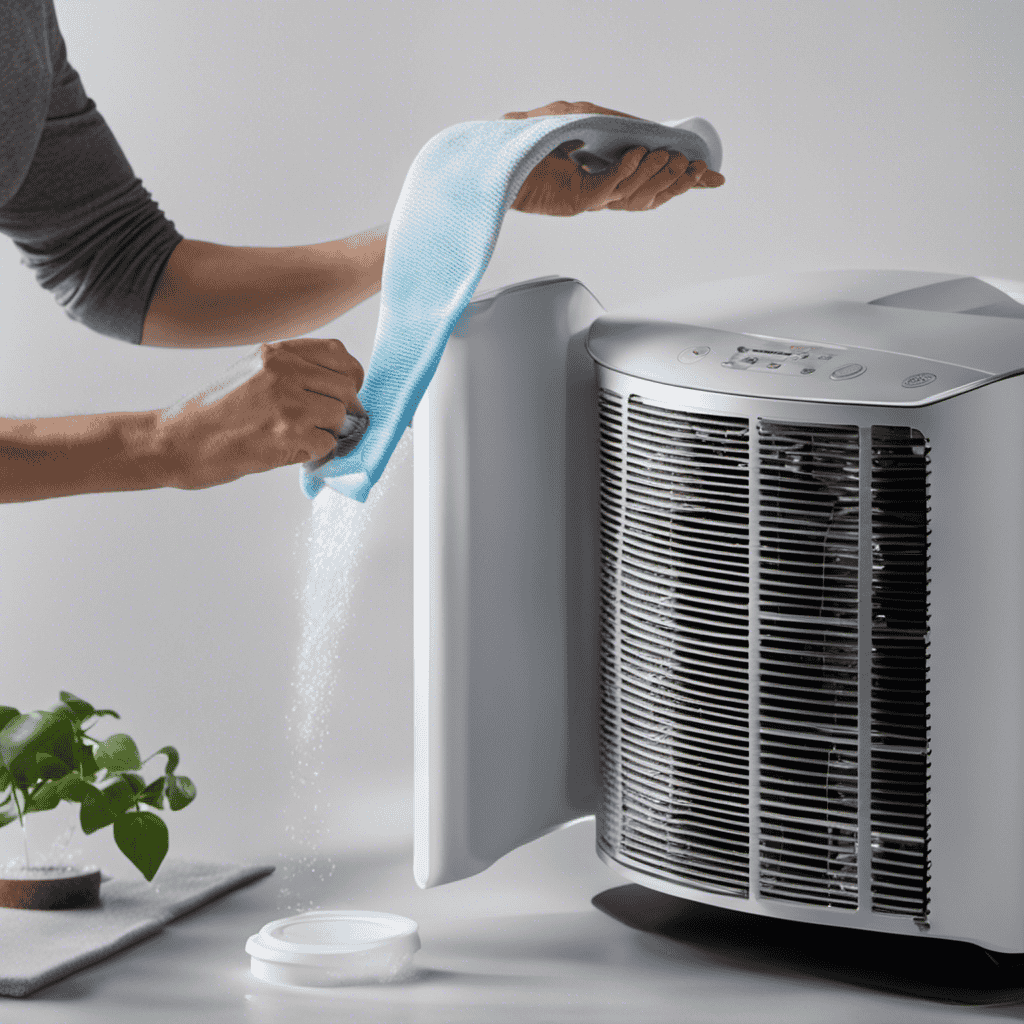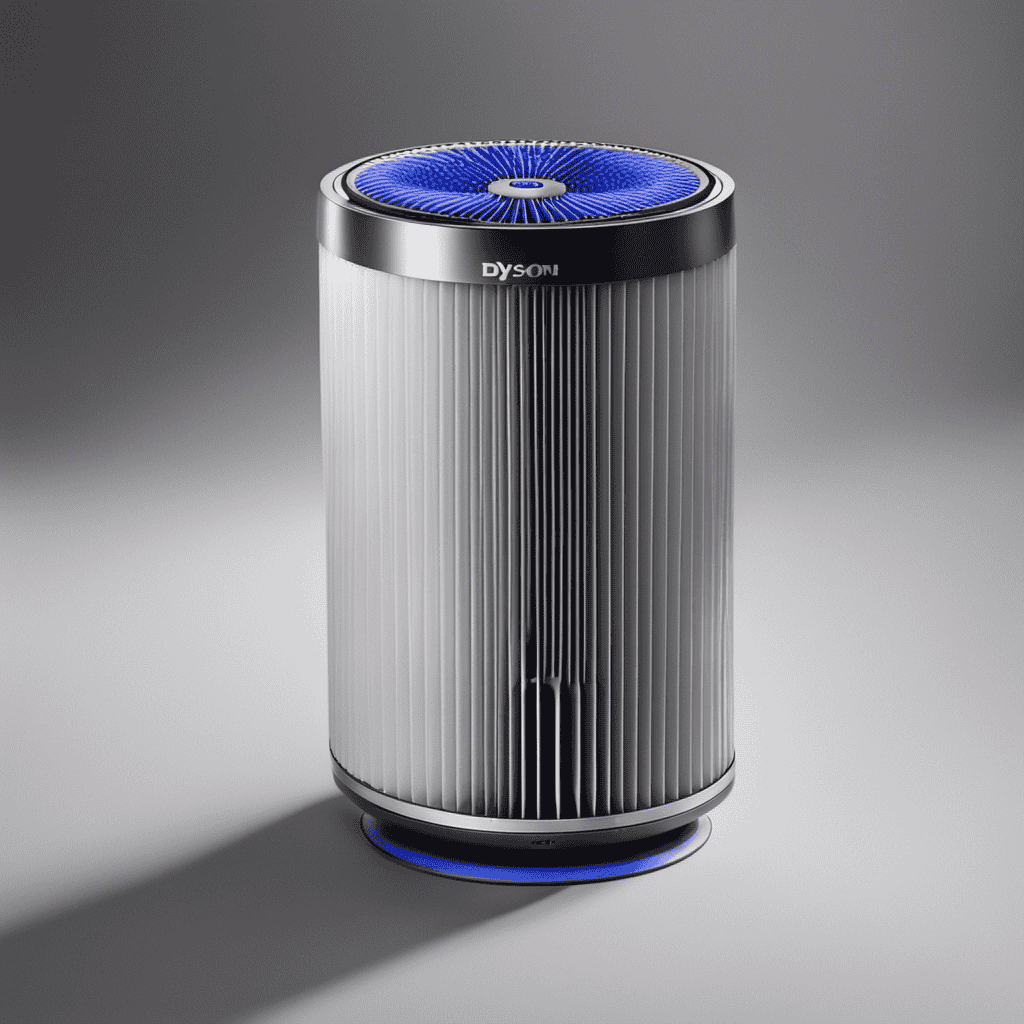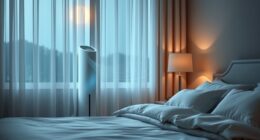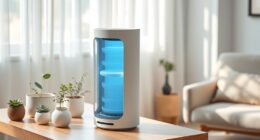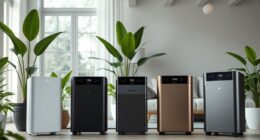Sure thing, people, let’s explore the realm of air purifiers and how to properly care for them.
Today, I’m going to show you how to clean your air purifier like a pro. Regular cleaning is crucial to ensure your purifier operates at maximum efficiency, keeping your indoor air fresh and clean.
So, grab your supplies and let’s get started.
First things first, turn off and unplug that trusty purifier of yours. We don’t want any unwanted surprises while we’re giving it a good scrub.
Key Takeaways
- Regular cleaning maintains air purifier effectiveness
- Cleaning the filters is essential for maintaining optimal performance
- Understanding different filter types: HEPA and activated carbon
- Cleaning other components such as ionizer plates, fan, vents, and exterior promotes effective and safe cleaning.
Understanding the Importance of Regular Air Purifier Cleaning
Regularly cleaning your air purifier is crucial for maintaining its effectiveness. Understanding the importance of regular maintenance is essential to ensure that your air purifier continues to provide you with clean and fresh air. By regularly cleaning your air purifier, you can remove dirt, dust, and other airborne particles that accumulate over time. This not only improves the air quality in your home but also helps to prolong the lifespan of your air purifier.
Clean air is beneficial for your overall health and well-being. It can reduce respiratory issues, allergies, and asthma symptoms, and promote better sleep. To ensure that your air purifier is properly cleaned, it is important to gather the necessary supplies for air purifier cleaning.
Gathering the Necessary Supplies for Air Purifier Cleaning
Before starting, make sure you have all the supplies needed to clean your air purifier. Understanding filter types and troubleshooting air purifier issues are crucial for ensuring optimal performance.
For cleaning, you will need a soft cloth or sponge, mild detergent or vinegar, water, and a vacuum cleaner with a brush attachment. The soft cloth or sponge will be used to wipe down the exterior of the air purifier and remove any dust or dirt.
The mild detergent or vinegar mixed with water will help to clean the filter and remove any trapped particles. The vacuum cleaner with a brush attachment will assist in removing debris from the vents and grills.
Turning Off and Unplugging the Air Purifier
Make sure to turn off and unplug the air purifier before beginning the cleaning process. This step is crucial for your safety and to prevent any damage to the purifier.
Understanding the safety precautions is essential to avoid any accidents or electrical hazards. To start, locate the power button on the purifier and switch it off. Once the unit is turned off, unplug it from the electrical outlet. This will ensure that there is no power running through the purifier while you clean it.
Remember to handle the device with care and follow the manufacturer’s instructions for safe handling. By taking these precautions, you can proceed with confidence to clean your air purifier effectively.
Removing and Cleaning the Pre-Filter
Once you’ve turned off and unplugged the air purifier, it’s time to remove and clean the pre-filter. Proper pre-filter maintenance is essential for keeping your air purifier working effectively and efficiently.
Cleaning the pre-filter is a simple process that can be done in a few easy steps. First, locate the pre-filter compartment, which is usually at the front or top of the air purifier. Open the compartment and carefully remove the pre-filter.
Shake the pre-filter gently to remove any loose dust or debris. Next, rinse the pre-filter under running water to remove stubborn dirt. Use a soft brush or toothbrush to gently scrub the pre-filter if necessary.
Allow the pre-filter to air dry completely before reinserting it back into the air purifier. Following these pre-filter cleaning techniques will help ensure that your air purifier continues to provide you with clean, fresh air.
Cleaning the HEPA Filter
When it comes to maintaining the filters in your air purifier, there are a few key tips to keep in mind.
First, it’s important to regularly clean and replace the filters to ensure optimal performance.
Additionally, the frequency of filter cleaning will depend on factors such as the air quality in your area and the level of pollutants in your home.
Filter Maintenance Tips
To ensure optimal performance, it’s important to regularly clean and replace the filters in your air purifier. Here are some filter maintenance tips to keep your air purifier running smoothly:
-
Check the filter replacement schedule provided by the manufacturer. This will help you determine when it’s time to replace the filters.
-
Clean the pre-filter regularly by vacuuming or washing it with mild soap and water. This will help remove larger particles and prolong the life of the main filter.
-
Make sure to dry the pre-filter completely before reinstalling it.
-
If the main filter is washable, follow the manufacturer’s instructions for cleaning it.
-
If you notice a decrease in air purifier performance or an increase in noise, it may be a sign that the filters need to be replaced.
-
Keep track of the filter replacement dates to ensure you’re maintaining a clean and efficient air purifier.
Now that you know how to maintain your air purifier’s filters, let’s discuss the frequency of filter cleaning in the next section.
Frequency of Filter Cleaning
Remember to regularly check your air purifier’s filter cleaning schedule to ensure it is maintained and running efficiently. Regular maintenance is of utmost importance when it comes to prolonging the lifespan of your air purifier.
Filters play a crucial role in removing airborne pollutants from the indoor environment, such as dust, allergens, and pet dander. Over time, these filters can become clogged with debris and lose their effectiveness. By regularly cleaning the filters, you can ensure optimal performance and prevent the air purifier from overworking.
The frequency of filter cleaning depends on various factors, including the manufacturer’s recommendations, the air quality in your home, and the number of occupants. It is recommended to clean or replace the filters every three to six months, but it is essential to check the specific guidelines provided by the manufacturer for your air purifier model.
Cleaning the Activated Carbon Filter
When it comes to maintaining the filters in your air purifier, there are a few key tips to keep in mind.
First and foremost, regular cleaning is essential to ensure optimal performance and prolong the lifespan of the filters. The frequency of cleaning will depend on factors such as the manufacturer’s recommendations, the quality of the air in your environment, and the usage of the air purifier.
Filter Maintenance Tips
Cleaning the air purifier’s filters regularly helps to maintain optimal performance. To ensure proper filter maintenance, it is essential to understand the different types of filters and common issues that may arise. Here are some tips to help you stay on top of your air purifier’s filter maintenance:
-
Understanding Filter Types:
-
HEPA Filters: These filters are highly effective at capturing small particles, such as dust, pollen, and pet dander.
-
Activated Carbon Filters: These filters are designed to remove odors, chemicals, and volatile organic compounds (VOCs) from the air.
-
Troubleshooting Common Filter Issues:
-
Clogging: If you notice reduced airflow or a strong odor, it may indicate that the filters are clogged and need cleaning or replacement.
-
Mold Growth: In humid environments, mold can grow on the filters. Regularly inspect the filters and clean or replace them if you spot any mold.
Regularly cleaning your air purifier’s filters is crucial for maintaining its effectiveness. Now let’s move on to the next section, where we will discuss cleaning frequency recommendations.
Cleaning Frequency Recommendations
To ensure optimal performance, it’s important for you to regularly maintain your air purifier’s filters by following these cleaning frequency recommendations. Understanding the cleaning methods for your air purifier can help you keep the filters in top condition and extend their lifespan. Regular maintenance offers numerous benefits, including improved air quality, reduced allergens, and increased energy efficiency. By keeping your filters clean, you can ensure that your air purifier effectively removes dust, pollen, pet dander, and other pollutants from the air in your home or office. The table below provides recommended cleaning frequencies for different types of air purifiers, based on manufacturer guidelines and expert recommendations. Following these guidelines will help you keep your air purifier running smoothly and ensure that it continues to provide clean and fresh air for you and your family.
| Air Purifier Type | Cleaning Frequency |
|---|---|
| HEPA | Every 3 months |
| Carbon | Every 6 months |
| Pre-filter | Every month |
| Electrostatic | Every month |
| UV-C | Every 6 months |
Cleaning the Ionizer Plates (If Applicable
You’ll want to make sure the ionizer plates are clean before reassembling the air purifier. Cleaning the ionizer plates is an essential part of maintaining the functionality of your air purifier. Here’s a step-by-step guide to help you clean the ionizer plates properly:
-
Turn off and unplug the air purifier to ensure your safety.
-
Remove the front cover or access panel of the air purifier to expose the ionizer plates.
- Use a screwdriver or follow the manufacturer’s instructions for removing the cover.
- Be gentle to avoid damaging any components.
-
Carefully remove the ionizer plates from the air purifier.
- Check for any visible dirt, dust, or debris on the plates.
- Use a soft brush or cloth to gently wipe away the dirt.
-
If the ionizer plates are heavily soiled, you can soak them in warm soapy water for a few minutes.
- Avoid using harsh chemicals or abrasive cleaning solutions.
-
Rinse the plates thoroughly with clean water and let them air dry completely.
-
Once the plates are dry, reinsert them back into the air purifier.
-
Put the front cover or access panel back in place and secure it properly.
-
Plug in the air purifier and turn it on to ensure everything is working correctly.
Cleaning the Fan and Vents
Once you’ve finished maintaining the ionizer plates, it’s important to also clean the fan and vents of your air purifier. The fan and vents can accumulate dust over time, which can affect the efficiency of the air purifier.
To clean the fan and vents, follow these steps:
- Turn off the air purifier and unplug it from the power source.
- Use a soft brush or a vacuum cleaner with a brush attachment to gently clean the fan blades. Be careful not to damage the blades.
- Use a damp cloth or a cotton swab to clean the vents, removing any dust or debris that may have accumulated.
- Allow the fan and vents to dry completely before plugging the air purifier back in.
By cleaning the blades and removing dust from the vents, you can ensure that your air purifier continues to function effectively.
Now let’s move on to cleaning the exterior of the air purifier.
Cleaning the Exterior of the Air Purifier
When it comes to cleaning the exterior of an air purifier, it is important to follow proper cleaning techniques to ensure effective and safe cleaning.
One should also consider the recommended cleaning frequency to maintain the optimal performance of the air purifier.
Additionally, using suitable cleaning products that are gentle yet effective is crucial to avoid damaging the device.
Proper Cleaning Techniques
To properly clean your air purifier, start by unplugging it from the power source. This ensures your safety and prevents any damage to the purifier. Once unplugged, follow these proper cleaning techniques to maintain its efficiency:
-
Cleaning the Filters:
-
Gently remove the filters from the purifier.
-
Use a soft brush or vacuum cleaner to remove dust and debris.
-
If the filters are washable, rinse them with water and mild detergent. Allow them to dry completely before reinserting.
-
Cleaning the Exterior:
-
Wipe the exterior of the purifier with a damp cloth.
-
Use a mild detergent solution for stubborn stains.
-
Avoid using abrasive cleaners or harsh chemicals, as they can damage the surface.
By following these proper cleaning techniques, you can ensure that your air purifier continues to provide clean and fresh air.
Avoid common cleaning mistakes such as neglecting to clean the filters regularly or using harsh chemicals, as they can compromise the performance of your purifier.
Recommended Cleaning Frequency
It’s important to regularly clean your filters to maintain the efficiency of your air purifier. Proper cleaning frequency can vary depending on factors such as the environment and usage. To help you determine the recommended cleaning frequency for your air purifier, here is a table outlining some general guidelines:
| Type of Filter | Recommended Cleaning Frequency |
|---|---|
| Pre-filter | Every 1-3 months |
| HEPA Filter | Every 6-12 months |
| Carbon Filter | Every 6-12 months |
| UV-C Light | Every 6-12 months |
These are just general recommendations, and it’s important to refer to your air purifier’s user manual for specific instructions. Additionally, it’s crucial to avoid common cleaning mistakes such as using harsh chemicals or excessive water, as these can damage the filters and reduce their effectiveness. Regularly cleaning your air purifier filters will help ensure that it continues to efficiently remove pollutants from the air, providing you with clean and fresh indoor air quality.
Suitable Cleaning Products
Using gentle and non-abrasive cleaning products is essential for maintaining the effectiveness of your filters. When it comes to cleaning your air purifier, there are suitable cleaning techniques that can help ensure its longevity and optimal performance. Here are some alternative cleaning methods to consider:
-
Use a microfiber cloth or soft brush to gently wipe away dust and debris from the exterior of the unit.
-
For the filters, follow the manufacturer’s instructions for removal and cleaning. Some filters may be washable, while others may need to be replaced.
-
If the filters are washable, rinse them with lukewarm water and a mild detergent. Avoid using harsh chemicals or scrubbing vigorously.
-
Allow the filters to air dry completely before reinserting them into the air purifier.
By using suitable cleaning techniques and alternative cleaning methods, you can ensure that your air purifier stays in top condition.
Now, let’s move on to reassembling the air purifier.
Reassembling the Air Purifier
First, make sure to gather all the necessary components before reassembling the air purifier. This will ensure a smooth and efficient process. To help you with the reassembly, here are some tips that can come in handy:
-
Refer to the user manual: The user manual provides detailed instructions on how to properly reassemble the air purifier. It is important to follow these instructions to avoid any issues or damage.
-
Take note of the disassembly process: Before taking apart the air purifier, it is helpful to document the disassembly process. This will make it easier to remember the correct order of components during reassembly.
Here is a table that outlines the common components and their proper placement during reassembly:
| Component | Placement |
|---|---|
| Filters | Insert into designated slots |
| Housing | Align and secure with screws |
| Control panel | Attach to the front of the housing |
| Power cord | Connect to the appropriate port |
Testing the Air Purifier After Cleaning
Once you have finished cleaning the air purifier, you can test its functionality to ensure that it is working properly. Testing the effectiveness of your air purifier is crucial in maintaining good indoor air quality.
Here are a few steps to help you measure the air quality and test the performance of your air purifier:
-
Set up the air purifier in a room with known air quality issues, such as a room with high levels of dust or allergens.
-
Use an air quality monitor to measure the initial air quality in the room.
-
Turn on the air purifier and let it run for a specific period, such as 30 minutes or an hour.
-
Measure the air quality again using the air quality monitor.
-
Compare the initial and final air quality readings to determine the effectiveness of the air purifier in removing pollutants.
Frequently Asked Questions
How Often Should I Clean My Air Purifier?
I replace the filters in my air purifier every 3-6 months, depending on usage. Signs that it needs cleaning include reduced airflow and a dusty or musty smell.
Can I Use Regular Household Cleaning Products to Clean My Air Purifier?
Yes, regular household cleaning products can be used to clean your air purifier. However, it’s important to follow the manufacturer’s instructions and avoid common mistakes such as using abrasive materials or submerging the unit in water.
Is It Safe to Wash the Filters of My Air Purifier?
Yes, it is safe to wash the filters of my air purifier. I have found that using gentle cleaning methods, such as rinsing with water and mild soap, effectively removes dirt and debris without damaging the filters.
Can I Clean the Ionizer Plates With Water?
Yes, you can clean the ionizer plates with water. It is important to properly maintain the ionizer plates to ensure optimal performance of your air purifier. Regular cleaning will help remove accumulated dust and improve air quality.
Should I Clean the Exterior of the Air Purifier With a Damp Cloth or a Dry Cloth?
When considering the best method for cleaning the exterior of the air purifier, it is important to determine whether a damp cloth or a dry cloth is more suitable.
Conclusion
After going through the meticulous process of cleaning an air purifier, one might wonder if it’s all worth it.
I mean, who needs clean air anyway? It’s not like we need it to survive or anything. So why waste time and effort on something as trivial as breathing fresh, clean air?
Let’s just embrace the stale, dusty air and live in blissful ignorance. Who needs clean lungs when we can have clogged ones instead?
So go ahead, neglect your air purifier and let it gather dust, because who needs clean air anyway?
